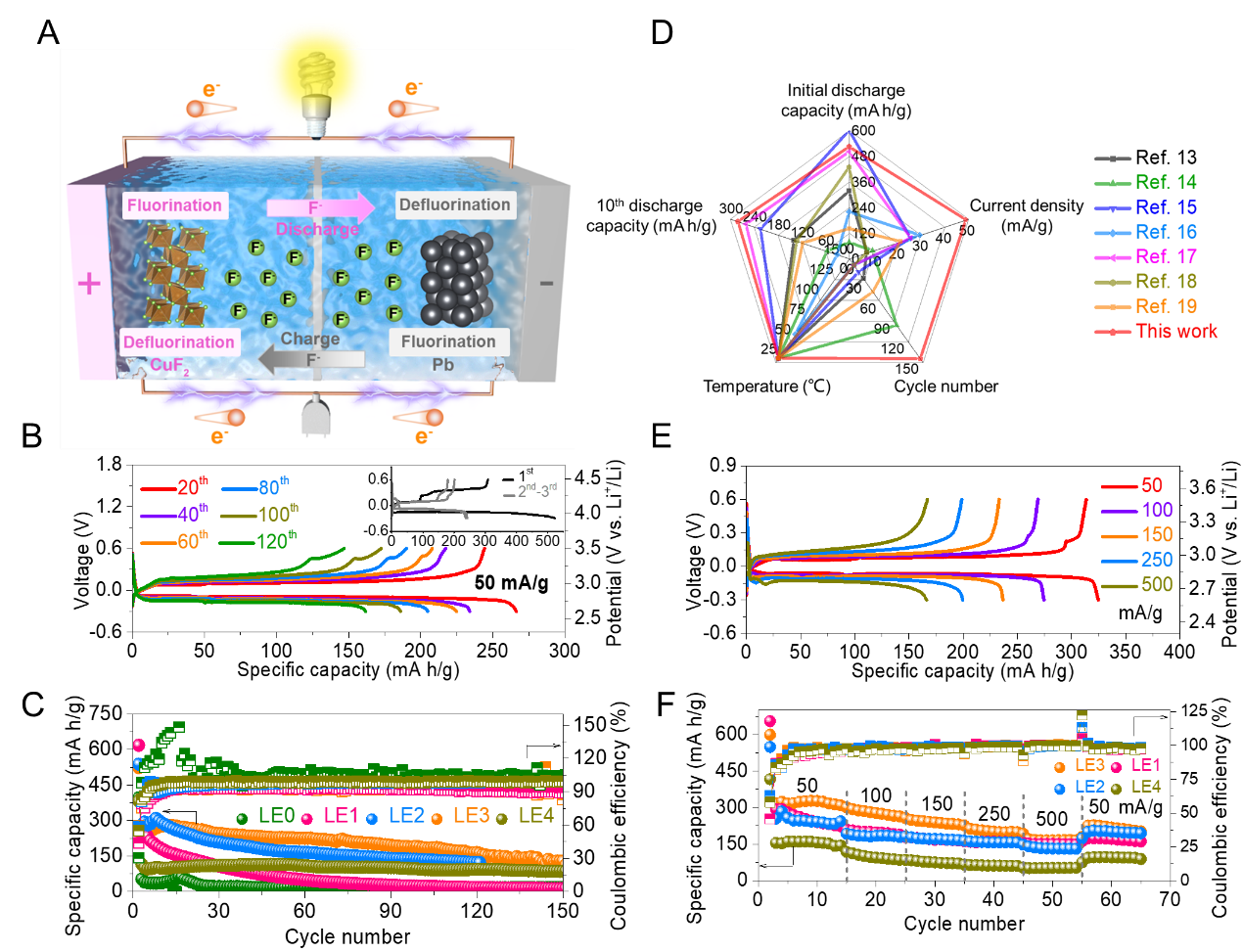Shanghai Institute of Ceramics Developed the Large-size F-Ion Pouch Cells Enabled by Green Electrolytes
Achieving the multielectron transfer reaction is an important pathway to design high energy density storage batteries. Compared with the sluggish kinetics of migration and desolvation of multivalent cations, the conversion-type fluoride ion batteries (FIBs) based on univalent F- shuttling have the advantage of better reaction kinetics. Meanwhile, relying on the multielectron reaction of multivalent metal fluoride cathode and its high reaction potential, FIBs could achieve the extremely high volumetric energy density theoretically. Discovering suitable electrolytes is currently one of the important tasks for studies on FIBs. Solid-state F-ion conductors such as tysonites and fluorites need a high temperature to activate the ion migration, and the room-temperature solid electrolytes suffer from an unsatisfactory rate capability and cycling stability because of potential interface issues. Compared with solid electrolytes, organic liquid electrolytes, owing to the better electrode wetting, can avoid the construction of additional solid F- shuttling path (as in the electrodes of solid state batteries) and improve the energy density of battery. Different from Li ion batteries, the development on liquid electrolytes for FIBs lags further behind the solid electrolytes. The main difficulty is that fluoride salts usually have a low solubility in organic solvents due to the strong lattice energy of salts. Even if the additives with Lewis acidity can promote the dissolution of fluoride salts, the highly nucleophilic attacking of F?ions toward the acidic atoms of solvent molecules often case the side reactions and lead to the poor cell performance.
To address these issues, Prof. Chilin Li from Shanghai Institute of Ceramics, Chinese Academy of Sciences and his team unite with the team led by Prof. Yi-Yang Sun, and propose a protic-type electrolyte based on the weakened solvation strategy. The main idea is to ensure a suitable solvation strength of ethylene glycol (EG) solvent to F?ion, avoiding the thermodynamic barriers at the interface between electrode and electrolyte. Here the protic solvent (EG) which can readily dissolve fluoride salts such as CsF serves as the main solvent firstly, and then the solvation regulator (choline chloride, ChCl) is used to tune the solubility of CsF. The optimized EG-ChCl-CsF electrolyte enables the high reversible cycling of coin F-ion cells at room temperature, with a reversible capacity of 166 mAh/g at a high current density of 500 mA/g (close to 1 C of high rate), as well as achieves the configuration and reversible cycling of larger-sized pouch cell for the first time, with the initial and reversible capacities of 525 and ~250 mAh/g (i.e., 6.72 and ~3 mAh), respectively. The strategy in this work is expected to make the FIBs proceed beyond the proof-of-concept stage, exhibiting the potentiality of practical battery with attractive specification. The relevant achievement is published in ACS Energy Letters, 2024, 9, 1008-1016, titled ” High-Capacity and Long-Cycling F?Ion Pouch Cells Enabled by Green Electrolytes” .
This work first evaluates the influence of different concentration of ChCl on the solvation degree of F? ion in EG. Through the solubility test, 19F nuclear magnetic resonance (19F NMR) and molecular dynamics (MD) simulations, it demonstrates that ChCl can significantly regulate the solvation strength of EG solvent to F? ions. ChCl substitutes part of EG molecules and participate in the formation of solvation sheath structure around F- ions, through the hydrogen bond interaction with F?ions. Since ChCl has a larger volume than EG, the original sheath structure which only consists of EG molecules is expanded, beneficial to the F- desolvation. Electrochemical performance tests indicate that, besides the ionic conductivity of electrolyte, the addition of ChCl also regulates the wettability of electrolyte on separator, and the interaction between ChCl and EG can also improve the electrochemical stability of electrolyte. Based on this series of electrolyte ( LEn, where n represents the different molar ratio of EG to ChCl), the CuF2 as cathode and Pb as anode are used to assemble the room-temperature FIB cells. It is found that when the molar ratio of EG:ChCl is 3:1 (i.e., LE3), the ion conductivity of electrolyte and the wettability of electrolyte on separator are relatively optimal. With LE3 electrolyte, the FIB exhibits an initial capacity of 523 mAh/g at a current density of 50 mA/g, and a reversible capacity of 112 mAh/g is kept even after 150 cycles. It also achieves a reversible capacity of 166 mAh/g even at 500 mA/g (close to 1 C of high rate). The room-temperature F- ion pouch cell assembled with this optimal electrolyte, achieves 150 reversible cycles at a current density of 20 mA/g, and delivers a discharge specific capacity of 105 mAh/g (i.e., a capacity of 1.35 mAh) over 100 cycles, and its Coulombic efficiency (CE) is stabilized between 97% and 103%. Further, the characterization of phase evolution of anode and cathode reveals that the cathode undergoes the defluorination reaction and the anode undergoes the fluorination reaction during discharge process, expressed by CuF2(cathode) + Pb(anode) →Cu + PbF2. On the contrary, during the charge process, the reaction is reversed via Cu(cathode) + PbF2(anode)→CuF2 + Pb, confirming the F- ion shuttling reaction mechanism.
The first author of the paper is Yifan Yu, a Ph.D. student in Shanghai Institute of Ceramics, and the corresponding authors are Prof. Chilin Li and Prof. Yi-Yang Sun. This work is supported by National Natural Science Foundation of China, Shanghai Science and Technology Committee, and other funding agencies.
Paper link: https://pubs.acs.org/doi/10.1021/acsenergylett.3c02628




LI Chilin
Shanghai Institute of Ceramics
E-mail: chilinli@mail.sic.ac.cn



